Australia has been a regular, if relatively minor, player on the World table tennis scene since the World Championships in India, 1952. After rising to a peak of number 12 in the world in the men’s teams in 1979, Australia has struggled to maintain a place among the major powers of table tennis through the 1980’s and 1990’s, and currently are sitting on a world team ranking of 37.
On the women’s side, Australia has been a consistent, if not spectactular, performer on the world table tennis stage. Since 1989 Australia’s women have been ranked higher than the men,usually in the 20-30 range, and are currently rated at 22nd in the world listings, with two women ranked in the top 100 in the world.
Current Stars of Australian Table Tennis
Rankings are as of April 2005.
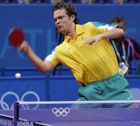 |
 |
| William Henzell (#197) | Miao Miao (#88) |
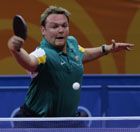 |
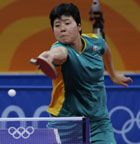 |
| Russell Lavale (#260) | Jian Fang Lay (#84) |
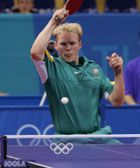 |
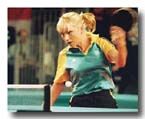 |
| Trevor Brown (#366) | Tammy Gough (#387) |
All above photos by: Mariann Domonkos, courtesy www.ittf.com
Australian Table Tennis – Hopes for the Future and Outlook
In the male ranks, Australia’s best hopes appear to be the trio of Kyle Davis, John Tawadrous, and Robert Frank. Tawadrous at 18 has had world championship experience from a very young age but may have lost focus of late, while Davis at 16 is currently knocking on the door for inclusion in the elite of the Australian men and a place in the World Championships and Olympics. Robert Frank is a young up-and-comer of around 14 who appears to have the talent to go a long way in the sport.
For Australia’s women’s future, Melissa Tapper looks to be a player with a lot of promise. Nicole Low did well at the last junior championship and could improve further. Other experienced juniors include Claire Campbell-Innes, Michelle Beaumont, and Michelle Carpenter.
Australian Table Tennis in the 1980’s and beyond
Australian World Championships Results |
||
| Year | Men’s Ranking | Women’s Ranking |
| 1979 | 12 | 25 |
| 1981 | 16 | 29 |
| 1983 | 24 | 29 |
| 1985 | 28 | 23 |
| 1987 | 19 | 28 |
| 1989 | 31 | 29 |
| 1991 | 31 | 25 |
| 1993 | 39 | 24 |
| 1995 | 49 | 23 |
| 1997 | 39 | 25 |
| 2000 | 45 | 21-24 |
| 2002 | Not held | Not held |
| 2004 | 37 | 22 |
From Australia’s peak in the 1979 World Championship, where the men achieved a ranking of 12 in the world and the women were number 25, the 1980’s saw the Australian men slowly slide down the ladder as their competitors in Europe and Asia became increasingly professional in their approach to table tennis. Australia’s women have fought hard during this period, and with the help of some Chinese imports along the way, have managed to maintain a relatively steady ranking in the 20-30 bracket.
1981 in Novi Sad saw the men’s team fall to number 16, while the women were ranked at number 29. This was Paul Pinkewich’s last worlds after being a stalwart of the team during the 1970’s.
The next Worlds were in Tokyo, Japan in 1983. Gary Haberl was introduced to the men’s team, which fell further down the ladder to 24 in the world, while our women held their position at 29 with the help of Nadia Bisiach.
In 1985 the World Championships were in Gothenberg, Sweden. This was the first time in some years that the women’s team outranked the men’s team, 23 to 28. It also marked the last Worlds for Bob Tuckett, a member of the team from the golden era of Australia table tennis in 1979.
1987, New Delhi, India, brought the first Worlds for women’s team member Kerri Tepper, who was to become a backbone of the team in years to come. It also saw the return of Paul Pinkewich who, together with Swedish import Tommy Danielsson and Gary Haberl, helped lift the mens team back to 19 in the world. The women meanwhile slipped down to 28th place.
1989 was the year Sweden broke the dominance of China in the men’s events in Dortmund, Germany. Along with veteran Glenn Tepper, Australia blooded some new talent in the men’s team with the introduction of Dennis Makaling and Eddie Kasser. The men’s team slid back to 31 in the world, while our women’s team kept up the status quo, falling one place to 29.
Chiba City, Japan was the scene for the 1991 Worlds. Our mens team brought in some more newcomers, with Jamie Perry and Peng Huy Quach making their debuts, and holding the team at a ranking of 31. In the women’s teams, selectors oversaw the introduction of two new Chinese imports in Catherine Ying Kwok and Gina Hui, who along with Kerri Tepper helped the women climb up to 25 in the world.
1993 saw the retun of the Worlds to Gothenberg in Sweden. Australia continued with its policy of blooding new men’s team members, this time bringing in Brett Clarke, Paul Langley, and Kent Jamieson to combine with Dennis Makaling and Jamie Perry. This didn’t help Australia keep up with the world though, and the men’s team fell to a low of 39. The women’s team, without Kerri Tepper for the first time since 1985, but bringing in Shirley Zhou as a replacement, managed a creditable 24th.
China hosted the 1995 Worlds for the first time in many years, in the city of Tianjin. Australia’s women’s team once again outshone our men, finishing 23rd in the world thanks to the efforts of Shirley Zhou, Catherine Ying Kwok and the returning Kerri Tepper. Our men’s team dropped further to 49th, as Russell Lavale made his world championship debut, and Dennis Makaling played his fourth and final Worlds.
1997 found the Worlds in Manchester, England, as the Australians returned to the mother country. In the women’s ranks, Australia brought in three new talents, these being Yvonne Li, Miao Miao, and Tammy Gough. Along with Shirley Zhou the women fought their way into 25th place. The men’s team also continued with it’s policy of youth, adding Mark Smythe, Trevor Brown and Simon Gerada to the existing team members of Russell Lavale and Paul Langley. This relatively young squad managed to lift Australia’s ranking to 39 in the world.
Eindhoven in the Netherlands hosted the 1999 World Championships for individual events only. The Australian team managed some creditable efforts, with Brett Clarke reaching the round of 128 in the men’s singles, while Miao Miao managed to do the same in the women’s singles and Shirley Zhou went one round better to get to the last 64 in the women’s singles.
Kuala Lumpur in Malaysia was the location for the 2000 World Teams Championships, and this time around found our women’s team of Shirley and Stella Zhou, as well as Miao Miao and Jian Fang Lay-Hong, come in at position 21-24 according to the ITTF website. Our men’s team of Trevor Brown, Brett Clarke and Simon Gerada slipped a bit further down to 45 in the world.
Back to the individual events in Osaka, Japan for 2001. The women’s team, absent a Zhou for the first time since 1991, brought in a few new faces as well as bringing back some other ones, as May Cho and Peri Campbell-Innes had their first taste of the World Championships, and Tammy Gough made her return along with Miao Miao, who made it to the last 64 in the women’s singles. The men’s team also included some fresh players, with William Henzell, John Tawadrous and Alexander Swanson making their debuts.
The 2002 World Teams was cancelled due to the troubles in Bosnia, and the inability to get a suitable last minute replacement host, so there was no action in 2002.
2003 saw the individual events take place in Paris, France. Australia’s best results came from Tammy Gough, who managed to make the last 128 in the women’s singles, and with her partner, May Cho, the last 64 in the women’s doubles. Other Australians making the trip to France included William Henzell, Trevor Brown, John Tawadrous, and David Zalcberg in the men’s, while Peri Campbell-Innes rounded out the women.
After skipping 2002, 2004 saw Qatar hold the World Teams in Doha. Australia fielded a variety of old and new members, with the women’s team seeing the return of Jian Fang Lay and the introduction of Mimi Lee to complement May Cho and Peri Campbell-Innes. Together the women managed a very creditable 22nd in the world. The men’s team also saw the return of Russell Lavale for the first time since 1997, and along with William Henzell, Trevor Brown and David Zalcberg the men’s team moved up to 37th place.
Now all eyes turn to Shanghai, China, for the 2005 World Individual Table Tennis Championships …
Table Tennis in Australia – Early Days to 1983
Below is the text of an article by Doug Stewart, printed in the Australian Table Tennis magazine of March 1985. Thanks go to Table Tennis Australia for permission to use this article. GL 14/6/2005
A Short History of Table Tennis in Australia
by Doug Stewart
Table Tennis in Australia, a country of some 14 million people, has progressed to quite a high standard. This is in spite of three geographical factors which make such an achievement more difficult than in nearly every other country in the world:
- Australia’s remoteness from the centres of world table tennis strength, which severely restricts participation in international competition.
- the sheer size of Australia, which even prevents the country’s own top players from meeting each other more than a few times each year.
- the year-long good weather which allows “competitive” sports such as tennis to be played outdoors all through the year.
Records show that Ping Pong Championships were held in Adelaide, South Australia, in 1898, and in the early 1900s the game was played in many of the major cities, but it was a temporary craze which subsided after a year or two.
In 1923, the South Australian Table Tennis Association was constitutionally formed and in the same year, the Oueensland Association was formed. The Victorian Association was formed in 1925, and prior to this date, competitions in Melbourne were played under Y.M.C.A. supervision. Teams competitions were played in Sydney before the New South Wales Association was formed in 1930.
Following interstate visits by these four Associations, the Australian Board of Control was formed in 1933. In the same year, the first Australian Championships were played at Melbourne, with teams from Victoria, Oueensland, New South Wales and South Australia participating, and only men players competed.
Affiliation with the lTTF was made in 1936, and in the same year the second national championship meeting was held, with events for women added to the program. The first official visit to Australia by visiting internationals was in 1937 when the world champion Hungarians Michael Szabados and Steven Kelen of Hungary toured. They played before a crowd of 5000 in Melbourne and were well received all over the country – so much so that both Szabados and Kelen subsequently returned to live in Sydney. Barna and Bellak came in the following year for another very successful tour and in 1940 the first official Australian team went overseas (K. Adamson and A. Bowe) to play in the Pan Pacific Tournament in Tokyo.
After World War II interest in table tennis slowly revived with the assistance of tours from Barna and Bergman (1949), Leach and Hagenauer (1951), Di and Ros Rowe (1953) and Bergman and Leach (1954). The exhibitions given by these World Champion players were one of the factors which contributed to an upsurge in table tennis in Australia at that time.
SZABADOS INFLUENCE
The other significant factor in Australian table tennis in the late 1940s and the 1950s was the coaching activity of Michael Szabados the former member of the Hungarian World Champion team of the 1930s. Szabados and his assistant coach Keith Bowler operated two table tennis academies in Sydney and were responsible for the development of top-class players including Phil Anderson, Geoff Jennings (the only Australian to reach the last 16 in men’s singles at a World Championship), Cliff McDonald and Michael Wilcox – and his own son Sandor – GL 17/1/08. Szabados was himself still a top player and won the Australian title twice in the 1950s but Anderson was the dominant player of that decade and McDonald and Wilcox dominated the 1960s.
Anderson was an amazing player. Two wins over Leach – partner to Szabados in the Tivoli circuit exhibitions throughout Australia and New Zealand – first played in the Australian nationals at the age of 31 (when most are thinking of retiring these days) – still representing South Australia at 48 – was ranked 13 times in the top 10 in Australia.
Anderson and Jennings, together with Arden Robinson and Vic Matison, were members of the first official Australian team to compete in the World Championships (1956) and five years earlier in 1951 Ron Jones of Melbourne was the first Australian to personally attend at lTTF Congress, in Vienna. Jones was secretary of the ATTA from 1937 to 1959 and was president from 1959 to 1967 – 30 years of service.
Karoly and Suzy Javor migrated to Melbourne from Hungary in the late 1950s and had an immediate impact on Australian table tennis. Suzy won the Australian women’s singles title 10 times between 1958 and 1970 and Karoly was also a regular tournament winner. Their son Robbie is a member of the current Australian team.
In 1961 Australia was granted the option to hold the World Championships in Melbourne in 1967, and this was confirmed in 1965. In 1966, however, the ITTF took the championships away from Australia because the Australian Government advised that it could not guarantee to give entry visas to any players from North Vietnam, and the championships were re-allocated to Stockholm. The disappoinment in Melbourne can only be imagined – Australia had suffered through doing the “right thing” – quite a contrast to the actions of some other nations in a variety of sports in recent years with bans and boycotts frequent.
The loss of the 1967 World Championshps led the Victorian TTA to hold the South-East Asian Pacific Area Table Tennis Championships in Melbourne in 1968. This tournament was a terrific success with World Champions Hasagawa and Itoh from Japan dominating. The SEAPATT tournament gave Australia another bonus – four players including Charlie Wuvanich of Thailand and David Lee Mun Chew of Malaysia decided to stay in Australia. It was the dynamic Wuvanich together with two “self-made Australians” Paul Pinkewich and Steve Knapp who were to guide Australia through its golden era of table tennis in the 1970s.
Pinkewich, a right-handed defensive player from Sydney, and Knapp, a left-handed attacker from Melbourne, financed their own trips over seas for coaching in Japan and Sweden and gradually raised their standard to world class. However, their positions in the Australian team were always under threat from another left-hander Bob Tuckett who kept them on their toes.
English coach Harry Venner worked in Melbourne for several years in the 1960s and his influence was considerable. He laid the foundations for Victoria’s present complete dominance of Australian table tennis.
STANDARD RISING
In the early 1970s there was already evidence of a gradual rise in the standard of play in Australia. The Australian men lost only 5-4 to England in the Commonwealth Championships in 1973 and in the same year a good-class Japanese side visited Australia and won the test series only 3-2.
In 1974 Czechoslovakia toured Australia – a powerful team comprising Orlowski (world ranked No. 6 at the time), Kunz (No. 21), Dvoracek, and Alicia Grofova ranked No. 3 on the world women’s list. They didn’t have it all their own way – Grofova was twice beaten by 14-year-old Leanne Merrow, Kunz lost an early match to another junior Neil Ward, and Australia had a sensational victory in the final test with Wuvanich and Tuckett winning the doubles against Orlowski/Kunz, Wuvanich winning his two singles against Orlowski and Dvoracek, and Tuckett blasting his way to a fantastic final win over Orlowski.
The 1975 World Championships in Calcutta saw Australia win Division 2 in the men’s competition and so gain promotion, with Pinkewich, Knapp and Wuvanich all contributing. Two weeks earlier the Commonwealth Championships had been very successfully staged in the Melbourne Town Hall, with Knapp runner-up in the men’s singles and Pinkewich/Tuckett runners-up in the doubles.
Later in 1975 a French team led by Jacques Secretin (then World ranked No. 14 and a year later to win the European title). Knapp recorded a good win over Secretin in one meeting.
In 1977 the Australian men were able to maintain their position in Division 1 at the World Championships even though Wuvanich had moved to the United States. His replacement, Tuckett, acquitted himself well. Also in 1977 the Wills organisation promoted the first of three very successful international tournaments with Neale defeating Furukawa in the final, and the Wagga TTA claimed a world record for successfully staging a 50-event open tournament over two days. Stellan Bengtsson and Kjell Johansson fought out the final of the Wills tournament in 1978 with the former successful, and Johansson was also beaten 22-20 in the fifth game by Laurie Skeate in the Queensland Open. Probably the best-ever win by an Australian women was recorded at the Asian Championships in Kuala Lumpur when Kerry Thompson defeated the World No. 2 Chang Li of China in a team match, in two games.
At Pyongyang in 1979 the Australian men finished No. 12 in the world and Knapp and Javor won the Commonwealth men’s doubles at Edinburgh. Maehara beat Thorsell in the Wills final and Pinkewich also bested Thorsell in the Queensland Open. Teams from China and Japan toured Australia in 1980 and 1981 and in the latter year the rising standards of play world-wide saw Australia demoted from Division I at the World Championships.
Reigning Japanese champion Meahara was defeated by the new Australian star Gary Haberl in the first round of the Asian Championships at Djakarta in 1982. This was a big year for table tennis in Australia with the Oceania Championships being held in Sydney and the sport also on exhibition at the Commonwealth Games in Brisbane. Another promising youngster Andrea Campbell set a record at the New South Wales titles by winning the open women’s singles and the Under 21, Under 17 and Under 15 events.
At the 1983 World Championships the Australian performance were not good by either men or women, but a glimpse of hope was seen in the fine play of the Australian girls’ team led by Kerri Tepper at the Asian Junior Championship in Bahrain. And last year there was a “step forward” for the older brigade with the holding of the first Australian Veterans Championships in Hobart.

